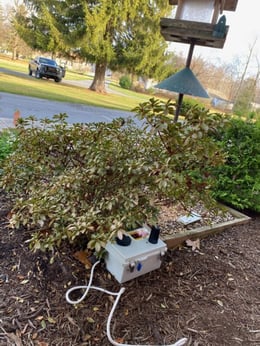Waynesboro Area School District: Community WiFi for a Rural District
Written by:
Krystle Pearson
The Challenges of Providing Connectivity in a Rural District
Waynesboro Area School District serves 4,300 K-12 students in Waynesboro, Pennsylvania. A district deeply committed to educating and empowering students for future success, Waynesboro launched Access4All in the 2017-2018 school year, a 1:1 program enabling students to take home Chromebook devices for after-school learning.
For students without Internet access at home, however, the benefits of school-issued Chromebooks are limited. Waynesboro has many rural areas with little wireless coverage – making it difficult for the students who live there to connect to the Internet from their homes. For other students and families, Internet access is not an affordable option.
“The issue is that for students in the rural part of our district, even if they have the ability to pay for Internet, it’s not available to them,” says Nic Erickson, Director of Technology Services at Waynesboro Area School District.
“And for those students whose families can’t afford Internet, they need connectivity too.”
COVID-19 and Shift to Remote Learning
When the COVID-19 pandemic hit in March 2020, necessitating an immediate shift to distance learning, students without reliable broadband Internet access at home were left disconnected and unable to access their schoolwork.
Related: Beekmantown Central School District: Student Connectivity in an Emergency
Erickson saw the breadth of this inequity and the impact it was having on students – and decided to do something about it. WASD had been awarded the Pennsylvania Department of Education Continuity of Education Equity Grant, which Erickson decided to put towards a district-wide digital equity initiative.
Erickson began researching ways to bring Internet connectivity out to students in a safe, sustainable way. Through careful evaluation and planning, he landed on the goal of creating community Internet locations in public spaces around the district where students could visit and safely connect to WiFi to complete their online schoolwork.
The next step: identifying a solution that would help Waynesboro accomplish it.
Identifying a Solution
Waynesboro teamed up with En-Net Services, an IT solution provider in Frederick, Maryland, to explore technology solutions that could meet the district’s needs. Greg Gordon, SLED Sales Manager, immediately connected Erickson and his team to Kajeet Solutions Engineers.
Erickson was already familiar with Kajeet connectivity solutions, and as he learned more, realized that the filtered wireless connectivity provided through the SmartBus solution would be a perfect fit for what Waynesboro hoped to accomplish in their district community.
Related: Complete Guide to School Bus WiFi
Not only does Kajeet offer reliable wireless coverage, but the CIPA-compliant filters and robust administrator platform, Sentinel, ensures the highest level of security and manageability.
In addition, Erickson could work with Kajeet Support to put the same SSID that is broadcasted in-school to be broadcasted to these SmartBus routers. This way, students’ school-issued Chromebooks would be immediately recognized by the network while other community members are prevented from accessing the WiFi for alternative purposes.
A Creative Application

Waynesboro purchased 23 portable Kajeet SmartBus units. Once these units arrived, Erickson and his team worked with Kajeet Support to put the same SSID that is broadcasted in-school to be broadcasted to these SmartBus routers. This way, students’ school-issued Chromebooks are immediately recognized by the network while parents and other community members are not able to access the WiFi for alternative purposes. They then installed the SmartBus routers in waterproof boxes to prepare them for placement around the community.
Next, the team needed to identify strategic locations around the district that could host these WiFi zones. Fortunately, the borough of Waynesboro and Washington Township had already reached out to Erickson seeking ways in which they could help provide WiFi connectivity to students during the pandemic, so they were eager to help with this new WASD initiative. Erickson worked with these public entities to select spaces that could host this connectivity – typically parks, public libraries, outdoor pavilions, natural areas, and community centers. Any safe, accessible public space with an adequate power source and space to allow social distancing was a candidate.

In order to communicate the location of these WiFi hotspots to families and students, Erickson created a webpage on the WASD district site all about the Community Internet Locations initiative. Through online map tools, he was able to build an interactive map of all WiFi zone locations throughout the community, along with relevant photos and detailed information specific to each location. When a new location opens up, Erickson simply updates the webpage to get the word out to students and families.
Currently, there are 11 active Community Internet Locations in Waynesboro, with two locations under development. One of these up-and-coming locations is at a community pool, which Erickson hopes will be available in time to support the summer learning that Waynesboro will offer to 6th-12th grade students.
Results and Impact
As we all know from experience, even the best technology initiatives cannot achieve success unless students actually utilize them. How have WASD students responded to these WiFi access opportunities?
Erickson has been glad to see that utilization has not been an issue in Waynesboro. On the contrary, Erickson can see through his Sentinel dashboard that all WiFi locations have been actively used by students – averaging nine devices and 11 users per day.
In March 2021 alone, the program logged a daily average of 172 hours and 1 minute of Learning Time across all WiFi locations – adding up to 5,332 hours and 29 minutes for the whole month.
Looking Ahead
Waynesboro Area School District plans to make a full or partial return to in-person learning in the fall, but Erickson expects the WiFi service WASD is providing to students to continue.
“For those remote learning days and synchronous virtual days that we may have, it provides a place for those students to go and access the Internet.”
“For those remote learning days and synchronous virtual days that we may have, it provides a place for those students to go and access the Internet.”
Three of WASD’s portable SmartBus units have been given to the athletic department, which the district has already begun using on athletic buses while traveling to away games, track meets, etc.
Likewise, Erickson reports that Waynesboro hopes to expand on this WiFi access in the future. From field trips and learning pods to STEM learning and outdoor learning experiences, the applications are as limitless as the creativity displayed by passionate educators like Erickson and the WASD staff.
Krystle Pearson
Krystle Pearson, M.Ed. is the Kajeet Education Sr. Marketing Manager, bringing with her 16 years of experience, including her most recent role as a K-12 Director of Technology. She also serves on the Executive Board for the Virginia Alliance of Black School Educators.
Other posts you might be interested in
View All Posts
SmartBus
10 min read
Raytown School District: Improved Bus Rider Behavior with SmartBus
Read More
SmartSpot
5 min read
Richland School District Two: Helping Spanish-Speaking Families Prosper
Read More
SmartBus
4 min read

